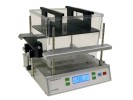Authors
P. Stucchi, M. Gil-Ortega, B. Merino, R. Guzmán-Ruiz, V. Cano et al.
Lab
Universidad Complutense de Madrid, Facultad de Farmacia, Instituto Pluridisciplinar and Departamento de Farmacología, Madrid, Spain.
Journal
Endocrinology
Abstract
High-fat (HF) diets trigger an increase in adipose tissue and body weight (BW) and disordered eating behavior. Our study deals with the hypothesis that circadian distribution of energy intake is more relevant for BW dynamics than diet composition. Four-week-old mice were exposed for 8 wk to a HF diet and compared with animals receiving control chow. HF mice progressively increased BW, decreased the amount of nocturnal (1800-0900 h) calories (energy or food intake) (30%) and increased diurnal (0900-1800 h) caloric intake (energy or food intake), although total daily intake was identical between groups. Animals were killed at 3-h intervals and plasma insulin, leptin, corticosterone, glucose, and fatty acid levels quantified. Adipose tissue was weighed, and enzymatic activities integral to the pentose phosphate pathway (PPP) assayed in lumbar adipose tissue. Phosphorylated AMP-dependent protein kinase and fatty acid synthase were quantified by Western blotting. In HF mice, there was a shift in the circadian oscillations of plasma parameters together with an inhibition of PPP activity and a decrease in phosphorylated AMP-dependent protein kinase and fatty acid synthase. In a second experiment, HF mice were forced to adhere to a circadian pattern of food intake similar to that in control animals. In this case, BW, adipose tissue, morning plasma parameters and PPP activity appeared to be normal. These data indicate that disordered feeding behavior can trigger BW gain independently of food composition and daily energy intake. Because PPP is the main source of reduced nicotinamide adenine dinucleotide phosphate, we suggest that PPP inhibition might be an early marker of adipose dysfunction in diet-induced obesity.
BIOSEB Instruments Used:
OXYLET, Indirect Calorimeter (OXYLET)

 Pain - Thermal Allodynia / Hyperalgesia
Pain - Thermal Allodynia / Hyperalgesia Pain - Spontaneous Pain - Postural Deficit
Pain - Spontaneous Pain - Postural Deficit Pain - Mechanical Allodynia / Hyperalgesia
Pain - Mechanical Allodynia / Hyperalgesia Learning/Memory - Attention - Addiction
Learning/Memory - Attention - Addiction Physiology & Respiratory Research
Physiology & Respiratory Research
 Pain
Pain Metabolism
Metabolism Motor control
Motor control Neurodegeneration
Neurodegeneration Cross-disciplinary subjects
Cross-disciplinary subjects Muscular system
Muscular system General activity
General activity Mood Disorders
Mood Disorders Other disorders
Other disorders Joints
Joints Central Nervous System (CNS)
Central Nervous System (CNS) Sensory system
Sensory system
